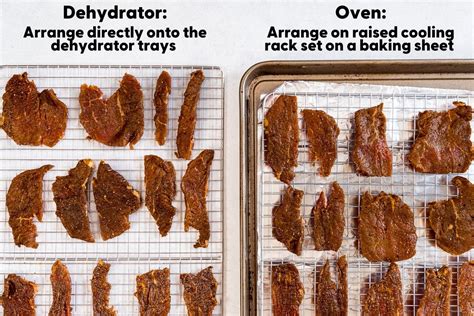The Ultimate Cheat Sheet: Beef Jerky Doneness Guide
Making perfect beef jerky is a blend of art and science. Getting the doneness just right is crucial; underdone jerky is unsafe, while overdone jerky is tough and unappetizing. This ultimate cheat sheet will guide you through achieving that ideal chewiness and flavor, ensuring your jerky is both delicious and safe to eat.
What Determines Beef Jerky Doneness?
The key to perfect beef jerky lies in understanding the interplay of time, temperature, and moisture content. We'll break each down:
- Time: The longer the jerky dehydrates, the drier it becomes. However, excessive drying can lead to toughness.
- Temperature: Low and slow is the mantra here. High heat will cook the jerky too quickly, resulting in a tough exterior and a raw interior. A consistent low temperature ensures even dehydration.
- Moisture Content: This is the ultimate indicator of doneness. The jerky should be dry and pliable, but not brittle or crumbly. A moisture meter is the most accurate way to measure this, but we'll explore visual and textural cues below.
Visual & Textural Indicators of Beef Jerky Doneness
While a moisture meter offers precise readings, visual and tactile cues are just as important:
- Color: The jerky should have a dark, rich brown color, almost mahogany in some cases. A lighter color suggests under-drying, while a very dark, almost black color indicates over-drying.
- Texture: The jerky should be firm and slightly pliable. It should bend without snapping but shouldn't feel rubbery or soft. If it bends too easily, it's underdone. If it snaps easily, it's overdone.
- Stickiness: There should be no stickiness whatsoever. If the jerky feels sticky, it's not dry enough and requires further dehydration.
Common Mistakes to Avoid When Making Beef Jerky
Avoiding these pitfalls will greatly increase your chances of jerky perfection:
- Using too much marinade: Excess marinade can hinder the drying process, leading to mold and spoilage.
- Inconsistency in temperature: Fluctuations in temperature can lead to uneven drying and unevenly cooked jerky.
- Overcrowding the dehydrator: Proper air circulation is key; overcrowding prevents efficient drying and can result in jerky that's chewy on the outside and raw on the inside.
- Not checking regularly: Consistent monitoring allows you to adjust the time and temperature as needed, ensuring even drying and the ideal texture.
How Long Does it Take to Make Beef Jerky?
The drying time varies considerably depending on several factors:
- Thickness of the meat: Thicker cuts take longer to dehydrate.
- Type of dehydrator: Different models have varying heating efficiencies.
- Ambient temperature and humidity: High humidity slows down the drying process.
Generally, expect drying times to range from 6-24 hours. Start checking for doneness around the 6-hour mark, and continue monitoring until you reach the desired texture and moisture content.
What Happens if My Beef Jerky is Underdone or Overdone?
- Underdone Jerky: Underdone jerky is a serious food safety concern. It can harbor harmful bacteria, leading to foodborne illnesses. If your jerky feels soft or sticky, discard it.
- Overdone Jerky: Overdone jerky will be tough and dry. While not unsafe to eat, its texture will be unpleasant.
Frequently Asked Questions (PAA)
Q: How do I know if beef jerky is safe to eat?
A: Safe beef jerky should be firm, dry, and free from stickiness. It should not feel soft or spongy. If there is any doubt about its safety, it is best to discard it.
Q: Can I make beef jerky in the oven?
A: Yes, but it requires careful monitoring and temperature control. Low and slow is key. Use a low oven temperature (around 170°F) and leave the oven door slightly ajar to allow moisture to escape. Check the jerky frequently.
Q: What’s the best cut of meat for beef jerky?
A: Top round, sirloin, eye of round, and flank steak are commonly used for jerky due to their lower fat content.
Q: How do I store beef jerky properly?
A: Store your jerky in an airtight container in a cool, dry place. Refrigeration is recommended to extend shelf life.
By following this guide and understanding the key indicators of doneness, you’ll be well on your way to creating delicious and safe beef jerky every time. Remember that practice makes perfect—experimentation and careful observation are your allies in mastering this craft!

